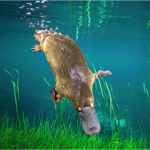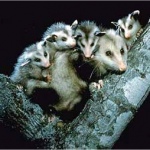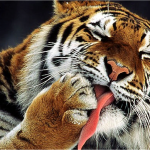4.6 See for Yourself
What can genes tell us about us about egg-laying mammals and the evolution of lactation?
Perhaps one of the most intriguing animals on earth is the platypus, a duck-billed mammal that lays eggs (figure 4). There are also a few marsupial mammals (e.g. kangaroos, opossums), organisms that complete gestation in specialized pouches. But most mammals gestate their young with the help of an organ called the placenta. Placental mammals include the primates (monkeys and apes), the carnivores (e.g., dogs and cats), the bats, and the cetaceans (e.g., dolphins and whales). The existence of three types of mammals raises several questions, including: which type of mammal evolved first—egg-laying (or monotreme), marsupial, or placental? Why don’t we all lay eggs? And finally, how can genes help us understand mammalian evolution?



The answers may lie in pseudogenes. A pseudogene is a gene that is no longer functioning. Sometimes these genes are called vestigial genes, because–like the snake’s limbs or the human appendix–pseudogenes are vestiges of an organism’s evolutionary past. Like other vestigial traits, pseudogenes can help us understand evolutionary history. In general, pseudogenes arise when a gene mutates, resulting in reduced or eliminated expression, without destroying the whole organism. These residues of once-functional genes are presumably the result of relaxed selection for a given protein. For example, genes for the egg yolk protein, vitellogenin, exist as remnants in the mammals. Of the three vitellogenin (VIT) genes found in mammals, all three are nonfunctional in the marsupial and placental mammals, but one is still active in the egg-laying mammal, the platypus.

See for yourself: the figure above illustrates a phylogeny of the three types of mammals, using birds as an outgroup for comparison. For each taxon, or group of organisms, you can see the status of its yolk protein, lactation, and vitellogenin genes. For example, birds lay eggs with extensive egg yolk protein; birds do not lactate, and they have three functioning egg yolk protein genes.
But how were placental and marsupial mammals able to give up production of yolk protein? Why didn’t natural selection eliminate mammals with yolk-less eggs?
While mammals are known for lactation, their sister taxa—the reptiles and birds—do not produce milk. Could mammalian lactation have relaxed selection on the genes for yolk protein? Scientists studying the egg yolk genes also identified the genes coding for the milk protein casein in all mammalian groups, and hypothesized that the ability to produce milk may have reduced selection pressure on the egg yolk proteins. In other words, when young could get their protein from milk, egg protein was less essential; as the VIT genes mutated to inactive variants, selection did not eliminate individuals possessing these mutant alleles. According to this logic, the egg-laying platypus represents a developmental and evolutionary compromise: the platypus produces some milk and some yolk protein, but excels at neither. Perhaps it’s no wonder we aren’t overrun with egg-laying mammals.
As with all legitimate science, these findings raise a host of new questions. For example, why don’t birds and reptiles, who also have genes for milk protein, have nipples and breastfeed their young?

